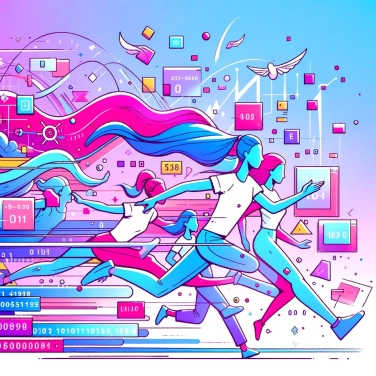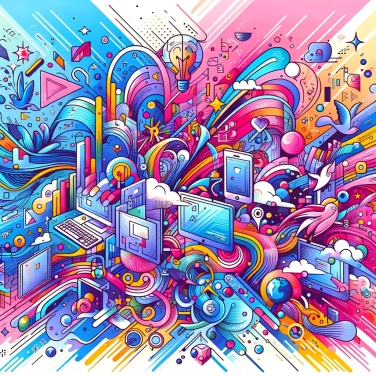Data is stored in bits and bytes because computers process information in binary form, meaning with 0s and 1s. A bit represents a binary value (0 or 1), and a byte is made up of 8 bits, thus offering a greater variety of possible combinations for codes and characters.

Computers speak the binary language, which consists solely of two states: 0 or 1. Why? Because electronic components like transistors can easily manage two simple physical states: current present or current absent, on or off. Manipulating two states is more reliable, faster, and above all, much less prone to errors than trying to manage numerous intermediate states. Each elementary state is called a bit (short for binary digit) — the smallest piece of information that can be manipulated by a computer. Combinations of these bits are sufficient to represent numbers, letters, images, or sounds, allowing for the storage of virtually any type of data with two basic and ultra-efficient electrical states.
An octet is simply a sequence of 8 bits, for example "01010101". This little band of eight bits can form up to 256 different combinations (yes, from 0 to 255, to be exact). Why is this important? Because the octet is the standard unit for storing information in computers. Whether it's text, photos, or your favorite song, the computer stores and processes everything with these little packets of 8 bits. When we talk about Ko, Mo, or Go, we are simply adding up a huge number of octets. Without octets, there is no simple and clear standardization of digital data.
Storing information in bits and bytes makes life easier for computers. Why? Because electronic circuits work in a binary way: current or no current, open or closed. This perfectly aligns with the states 1 or 0 of bits! This simplicity allows computers to process massive amounts of data incredibly quickly: calculations, memory storage, transfers to other devices, all of it is done using these little binary states. And when we group bits in packets of eight, called bytes, it becomes convenient to easily represent anything we want: characters, images, sounds, or videos. The computer can switch ultra-fast from one byte to another and manipulate them effortlessly — exactly what it needs to run at full speed.
A bit is a very basic unit, just a 0 or a 1: it's like a switch that is either on or off, that's all. An byte, on the other hand, is a group of 8 bits put together—this allows for more possibilities, such as representing a letter or a number.
Practically speaking, internet speeds are often measured in bits per second (like Mbps), because it reflects how much information is transmitted every second. However, for storage, like for USB drives or hard disks, we use bytes (GB, TB...), because we want to know how many characters, photos, videos, or other files can fit on them.
You see, bits for speed, bytes for capacity, each has its purpose.
Today, we are faced with a major challenge: managing the explosion of digital data volume. Our ultra HD videos, cloud computing, IoT, and the like constantly generate a mountain of bits and bytes. As a result, researchers have had to find ways to store even more information in increasingly smaller spaces: this is where new technologies come into play, such as ever denser flash memory, DNA storage inspired by biology, and quantum systems that could completely change the game. Another important issue is reducing the energy consumption associated with the storage and management of this data. Because, believe it or not, keeping all this data in data centers and transferring it all day long around the planet consumes a tremendous amount of energy. Therefore, we are seriously considering how to make all of this more sustainable and greener.
Although today's computer hardware is sophisticated, the internal language of computers still strictly relies on two electric voltages representing bits 0 and 1, just as it did in the early days of computing.
Storing a single alphanumeric character (like a letter) usually requires 1 byte, while a simple colored pixel often needs between 3 and 4 bytes to represent all the shades of a modern digital image.
The current storage capacities are so vast that the prefix 'yotta-' has been introduced to represent 10^24 bytes, an amount equivalent to about one trillion 1 TB hard drives.
The origin of the term 'octet' comes from the Latin 'octo', meaning eight, because an octet contains exactly 8 bits. In English, 'octet' is referred to as 'byte', a term originally adopted to avoid confusion with the pronunciation of the word 'bit'.
In practice, digital computing mainly uses binary storage in bits and bytes due to its simplicity and hardware reliability. However, some research explores alternatives such as quantum computing using qubits, which can exist simultaneously in multiple states (superposition), potentially offering entirely new forms of data storage and processing.
The size is indicated in bytes mainly for convenience and simplicity. A byte, which consists of eight bits, is easier for humans to manipulate and visualize, as it is a sufficiently large unit to clearly represent various common characters encountered in daily life (letters, numbers, symbols).
A bit (binary digit) is the basic unit of information in computing, capable of taking the value of 0 or 1. A byte consists of 8 bits. The byte thus serves as a standardized unit that allows for the clear representation of characters such as letters, numbers, and symbols, facilitating the storage, management, and exchange of more complex information.
Computers are built from electronic components such as transistors, which naturally switch between two states, on or off, corresponding to 0 or 1. Thus, the binary system, using only two values (0 and 1), is the simplest, most efficient, reliable, and cost-effective method for representing computer data.
Sure! Here's the translation: "Yes, generally the data transfer speed is measured in bits per second (b/s or Mbps for megabits per second), while file sizes are expressed in bytes (MB, GB). It is important to understand this difference in order to accurately estimate the duration of data transfers or the speed of an internet connection, by converting bits and bytes as needed (1 byte = 8 bits)."

No one has answered this quiz yet, be the first!' :-)
Question 1/5